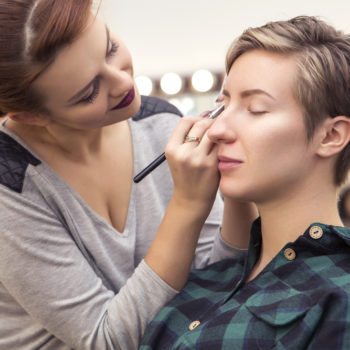Why We Love It
-
$73,180Potential Avg. Salary
-
3%Job Growth Rate
-
Growing DemandJob Outlook
-
Creativity FocusedCareer Attribute
Fashion designers create clothing, shoes, and accessories that appeal to consumers and are sold in retail outlets. They study consumer trends and employ creativity to create designs in styles, colors, and fabrics that are both appealing and unique. They choose the colors, fabrics, and embellishments for designs.
Recommended Schools
What is a Fashion Designer?
The following job responsibilities are common for individuals in fashion designer roles:
- Create spring and fall collections by studying fashion trends and anticipating what designs will appeal to consumers for the upcoming seasons
- Hand-sketch designs, create prototypes, and/or use computer-aided design equipment to see what designs will look like and to make adjustments if necessary
- Choose the colors, fabrics, textiles, and embellishments for designs in a collection
- Present designs to gather feedback, and make adjustments when necessary
- Oversee the mass production of designs for sale to retailers or directly to consumers
A Day in the Life
Fashion designers spend their days imagining what fashion will look like in the near future. Most fashion designers focus their work on creating annual spring and fall collections, but designing for these collections begins well before the season when designs will be released for sale. For this reason, fashion designers must study fashion trends—reviewing what styles and colors are appealing to consumers—and use that research to create designs that imagine what fashion will look like next season.
After researching and deciding on styles and themes for collections, the fashion designer begins designing the collection. He/she creates hand-drawn sketches, creates prototypes using lower-quality materials, and/or uses computer-aided design (CAD) software to get a feel for how designs will look once created. The fashion designer also chooses appropriate colors, fabrics, and textiles for pieces, and may choose what embellishments will appear on collection clothing, shoes, and accessories.
Fashion designers may work independently, creating their own designs and selling them to consumers through a website or branded storefront, or in mass quantities to retail outlets. Some may work in wholesale apparel with a team of other designers and a creative director, creating fashions for major clothing and accessories retailers. In either scenario, the designer typically reviews produced pieces to ensure that post-production fashions match original designs and maintain the integrity of the piece.
Typical Work Schedule
Fashion designers generally work full-time schedules, though there are no set hours for when a fashion designer conducts his/her work. Overtime is common when working on new collections, but ample time off may be available in breaks between designing new collections for upcoming seasons.
Projected Job Growth
While most upscale fashion design happens in international countries, there is a huge market for wholesale design in the U.S. Demand for fashion designers working in wholesale design is expected to increase significantly in the coming decade to create cost-friendly clothing, shoes, and accessories that mimic the styles of high fashion.
Fashion Designer Specializations
- Clothing designers design men’s, women’s, and children’s clothing for a variety of activities.
- Shoe designers create designs for different types of shoes, including dress shoes and tennis shoes for men, women, and children.
- Accessory designers create designs for purses, scarves, hats, and other popular accessories.
- Wholesale fashion designers create clothing, shoe, and accessory designs what mimic high-fashion but use lower-cost materials so that designs can be sold at a cost-friendly price in major retail outlets.
Typical Employers
Most fashion designers in the U.S. work for clothing, shoe, or accessory wholesalers. However, some are self-employed and maintain their own fashion label, creating high-fashion designs that can be sold to consumers via a website or branded storefront, or sold to retailers as part of a collection.
Recommended Schools
How To Become a Fashion Designer
The starting point for a career as a fashion designer is earning a bachelor’s degree in either fashion design or fashion merchandising. In college, you’ll learn how to use computer-aided design software, how to choose and identify fabrics and textiles, and how to put clothing, shoes, and accessories together. Thorough your class projects and any internships you may take while in college, you can begin building a portfolio of work. This portfolio will be required to apply for and find jobs after graduation.
After graduating from college, you’ll need to find entry-level work in the field. This is commonly achieved by working in internships or as an assistant to an experienced fashion designer. Working for a clothing, shoe, or accessory wholesaler may also help you gain the experience needed to advance into more prestigious positions over time. In these entry-level positions, you can learn the ins and outs of the trade and continue to refine your portfolio and make it more impressive.
Succeeding as a high-end fashion designer will require talent, quality marketing, and networking. It will be important to spend time expanding your network of connections, and you will also need to know how to market your fashion line and collections to both consumers and retail outlets in order to make enough sales to become profitable.
Fashion Designer Salary Data
We’ve provided you the following to learn more about this career. The salary and growth data on this page comes from recently published Bureau of Labor Statistics data while the recommendations and editorial content are based on our research.
National Anual Salary
Low Range
$44,880Average
$73,180High Range
$125,270National Hourly Wage
Low Range
$22/hrAverage
$35/hrHigh Range
$60/hrHow do Fashion Designer salaries stack up to other jobs across the country? Based on the latest jobs data nationwide, Fashion Designer's can make an average annual salary of $73,180, or $35 per hour. On the lower end, they can make $44,880 or $22 per hour, perhaps when just starting out or based on the state you live in.
Salary Rankings And Facts
#176 Nationally for All Careers
Above Average Salary Nationally
Programs and Degrees
Here are the most common degrees for becoming a Fashion Designer. a is usually recommended and specifically a degree or coursework that prepares you for the particular field, see below.
Highest Education Among Fashion Designers
- 1.4% Doctorate
- 8.7% Masters
- 47.4% Bachelors
- 12.7% Associates
- 17.6% College
- 9.8% High School
- 2.3% Less than High School
Job Growth Projections and Forecast
2014 Total Jobs
23,1002024 Est. Jobs
23,800Job Growth Rate
3%Est. New Jobs
700How does Fashion Designer job growth stack up to other jobs across the country? By 2024, there will be a change of 700 jobs for a total of 23,800 people employed in the career nationwide. This is a 3% change in growth over the next ten years, giving the career a growth rate nationwide of Above Average.
Growth Rankings And Facts
#520 Nationally for All Careers
Above Avg. Growth Nationally
What Companies Employ The Most Fashion Designers
| Industry | Current Jobs | New Jobs Needed | % Increase |
|---|---|---|---|
| Apparel, piece goods, and notions merchant wholesalers | 7,400 | 1,200 | 1% |
| Self-employed workers | 5,400 | 100 | 0% |
| Apparel manufacturing | 3,000 | -1,400 | -1% |














